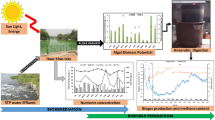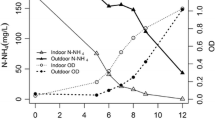Summary
An integrated system for the collection, treatment and utilisation of piggery wastewater has been developed in Singapore which uses the cultivation of microalgae in high rate ponds to achieve reduction of BOD5 and COD5 of the effluent as well as producing single cell protein. A wide range of algal flora occurs in the ponds;Oocystis, Micratinium, Scenedesmus, Ankistrodesmus, Chlorella andOscillatoria spp were identified. Total algal counts, recorded from 1979 to 1981, ranged up to 107 per ml of pond water. There were considerable variations in the algal population and in the predominating species. No discernible pattern was evident. Consequently pond operations were frequently disturbed by these fluctuations in population which in turn was attributed to the heterogeneous composition of the piggery waste, to variable weather conditions and to predation by larger organisms particularlyMoina. After passing through the ponds, the total suspended solids were removed by a novel dissolved air flotation method which gave a clear effluent showing an 87% reduction in BOD5 value.
Résumé
Un système intégré pour la collecte, le traitement et l'utilisation d'eaux résiduaires de porcherie a été développé à Singapoure. Il utilise la culture de micro-algues tant pour la réduction accélérée en lagune de la DBO5 et de la DCO de l'effluent que pour la production de protéines uni-cellulaires. On trouve une large gamme de flore algale dans les lagunes; des espèces d'-Oocystis, deMicratinium, deScenedesmus, Ankistrodesmus, deChlorella etd'Oscillatoria out été identifiées. Les comptages totaux d'algues, enregistrées de 1979 à 1981, ont donné jusqu' à 107 cellules par ml d'eau de la lagune. On a observé des variations considérables de population algale tant quantitatives que qualitatives. On ne discernait pas de spectres évidents. En conséquence, les opérations lagunaires ont été fréquemment perturbées par ces fermentations en population, qui, à leur tour, ont été attribuées à la composition hétérogène de l'effluent de porcherie, aux conditions atmosphériques et climatiques variables et à la prédation par des organismes plus conséquents, plus particulièrement desMoina. Après passage par les lagunes, les solides totaux en suspension ont été enlevés par une méthode nouvelle de flottation à l'air dissous, qui a donné un effluent limpide, présentant une réduction de DBO5 de 87%.
Resumen
En Singapur se ha desrrollado un sistema integrado para le recogida, tratamiento y utilización de aguas residuales de pocilgas. Este sistema usa el cultivo de microalgas en estanques, de caudal rápido afin de reducir las DBO5 y DCO5 del efluencte produciendo asimismo proteínas celulares. La flora de algas producida en estos estanques es amplia y variada, habiendose identificado:Oocystis, Micratinium, Scenesdemus, Ankistrodesmus, Chlorella y Oscillatoria. Los recuentos totales de algas tomados desde 1979 a 1981 llegaron a alcanzar 10;7 por ml de agua del estanque. Se observaron variaciones considerables tanto en la población total de algas como en las especies predominantes sin que se pudiese, determinar un patrón de variación característico. Estas fluctuaciones en la población, causantes de frecuentes alteraciones en el funcionamiento del estanque, se atribuyeron a la composición heterogenea de los resuduos, a las variaciones climáticas y la predación por otros organismos particularmenteMoina Después de su paso por los estanque los solidos suspendidos totales se eliminaron mediante un nuevo método de flotación con aire disuelto, obteniendose un efluente limpio con una reducción de la DBO5 del 87%.
Similar content being viewed by others
References
Anon. (1980) Standard methods for the analysis of water and wastewater, 15th Edition. American Public Health Association, Washington D.C.
Becker, W. E. (1978) Major results of the Indo-German microalgae project.Archives of Hydrobiology 11, 56–64
Ciferri, O. (1983)Spirulina, the edible microorganism.Microbiological Reviews 47, 551–578.
Dodd, J. C. &Anderson, J. L (1977) An integrated high rate pond algae harvesting system.Progress in Water Technology 9, 713–726.
Dodd, J. C. & Goh, A. (1982) Alage harvesting with a fine-weave belt filter. Proceedings of International Conference on Wastewater Treatment, University of Missouri, Missouri, U.S.A., 1–12.
Hendricks, F. &Bosman, J. (1980) The removal of nitrogen from an inorganic industrial effluent by means of intensive algal culture.Progress in Water Technology 12, 651–665.
McGarry, M. G. (1971) Water and protein reclamation from sewage.Process Biochemistry,6(1), 50–53.
Moraine, R., Shelef, G., Meydan, A. &Levi, A. (1979) Algal single cell protein from wastewater treatment and renovation process.Biotechnology and Bioengineering 21, 1191–1207.
Ngiam, M. F. &Thiruchelvam, S. (1982) A nutritive evaluation of pig wastewater, grown algae. Proceedings of Wastewater Treatment and Resource Recovery, (Ed. Lee, B. Y., Lee, K. W., McGarry, M. G. & Graham, M.) p. 45. International Development Research Centre, Canada.
Oswald, W. J. (1976) Pilot plant high-rate pond for study of waste treatment and algal production. In: Report for World Health Organisation, Regional Office for the Western Pacific, United Nations Ave., Manila, Philippines.
Oswald, W. J. &Benemann, J. R. (1977) Critical analysis of bioconversion with microalgae. In: Biological Solar Energy Conversion (Mitsui, A., Miyachi, S., San Pietro, A. and Tamura, S., editors), pp. 379–396. Academic Press Inc., New York.
Pirt, S. J. (1982) Microbial photosynthesis in the harnessing of solar energy.Journal of Chemical Technology & Biotechnology 32, 198–202.
Pirt, S. J., Lee, Y. K., Walach, M. R., Pirt, M. W., Hushang, H. M. &Bazin, M. J. (1983) A tubular bioreactor for photosynthetic production of biomass from carbon dioxide design and performance.Journal of Chemical Technology Biotechnology 33, 35–58.
Shelef, G., Azof, Y., Moraine, R. &Oron, G. (1980) Algal mass production as an integral part of a wastewater treatment and reclamation system. In:Algae Biomass (G. Shelef and C. J. Soeder, editors pp. 163–189. Elsevier-North Holland Press, Amsterdam.
Sim, T. S. (1982) Algal single cell protein for use in food or feed. Proceedings of seminar on food research and production, National University of Singapore, Singapore, 45–47.
Subbulakshmi, G., Becker, W. E. &Venkataraman, L. V. (1976) Effect of processing on the nutrient content of the green alga,Scenedesmus acutus.Nutrition Reports International 14, 581–591.
Venkataraman, L. V., Becker, W. E. &Shamala, T. R. (1977) Studies on the cultivation and utilisation of the algaScenedesmus acutus as a single cell protein.Life Sciences 20, 223–234.
Venkataraman, L. V. &Shivashankar, S. (1979) Studies on the extractability of proteins from the algaScenedesmus acutus. Archives of Hydrobiology,56, 114–126.
Wee, Y. C. (1982) Airborne alga around Singapore. International Biodegradation Bulletin,18, 1–5.
Author information
Authors and Affiliations
Rights and permissions
About this article
Cite this article
Sim, TS., Goh, A. Ecology of microalgae in a high rate pond for piggery effluent purification in Singapore. Mircen Journal 4, 285–297 (1988). https://doi.org/10.1007/BF01096134
Received:
Accepted:
Issue Date:
DOI: https://doi.org/10.1007/BF01096134




